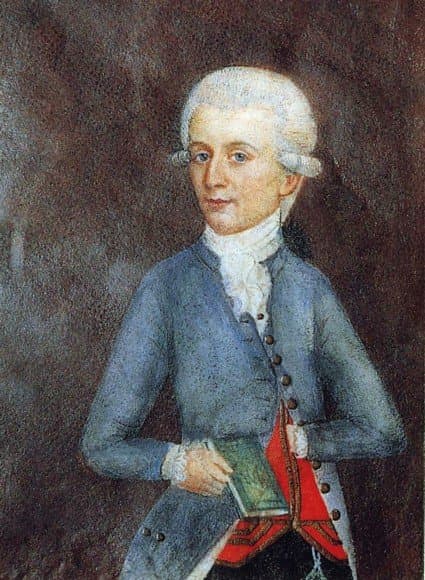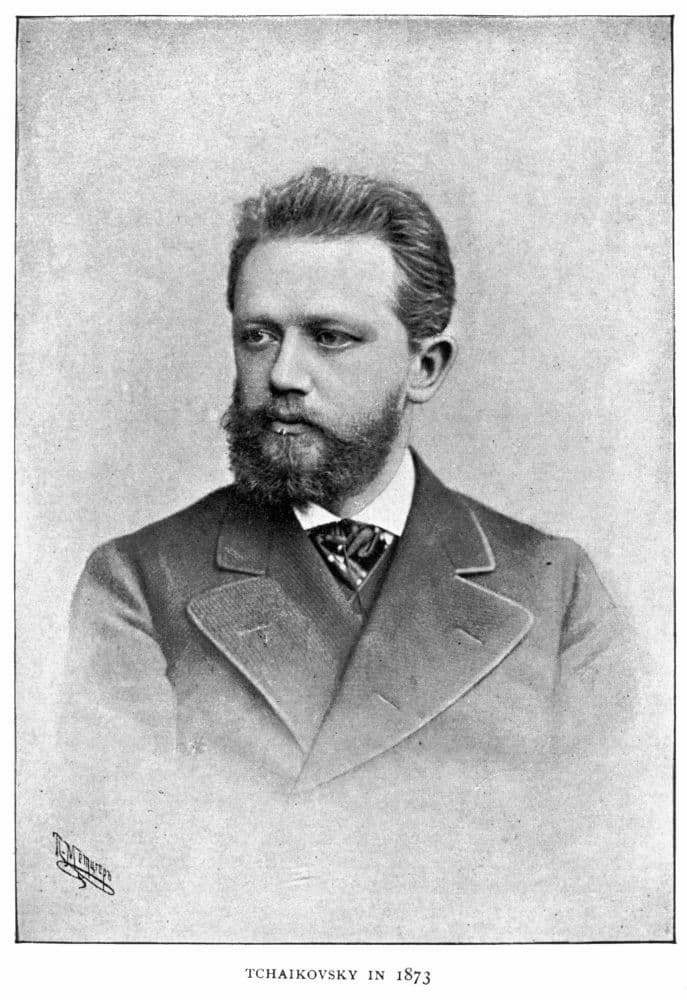Two composers we rarely think of together are the very Russian Pyotr Ilyich Tchaikovsky (1840–1893) and the very Viennese Mozart (1756–1791). Born fifty years apart, they couldn’t be more different in their style and sensibilities. Mozart had been trained in music since his childhood; Tchaikovsky was the first generation of professional Russian composers. However, even from his childhood, Tchaikovsky worshiped the music of Mozart.

Johann Nepomuk della Croce: Mozart, 1780 (Vienna: Mozarthaus)

Tchaikovsky, 1873
In 1884, while he was translating Le nozze di Figaro, Tchaikovsky had the idea to create a suite based on musical ideas from Mozart. 1887 was to be the celebration of the centenary of the premiere of Don Giovanni and so Tchaikovsky’s Fourth Suite, Mozartiana, came into being.
The first movement was based on Mozart’s Gigue in G major, K. 574.
Wolfgang Amadeus Mozart: Gigue in G Major, K. 574, “Leipziger Gigue” (Michael Wessel, piano)
Pyotr Ilyich Tchaikovsky: Suite No. 4 in G Major, Op. 61, “Mozartiana” – I. Gigue (Philharmonia Orchestra; Neeme Järvi, cond.)
It’s Mozart, but the orchestration brings out so much that was hidden in the music. The counterpoint comes through more clearly, and the tonal colours do much to bring out the Russian side of the music.
The second movement comes from Mozart’s Minuet in D major, K. 355.
Wolfgang Amadeus Mozart: Minuet in D Major, K. 355 (Ichiro Nodaira, piano)
Pyotr Ilyich Tchaikovsky: Suite No. 4 in G Major, Op. 61, “Mozartiana” – II. Gigue (Philharmonia Orchestra; Neeme Järvi, cond.)
Again, moving Mozart from the 1780s to the 1880s makes us hear him through different ears.
The third movement, based on Mozart’s Ave verum corpus, K. 618.
Wolfgang Amadeus Mozart: Ave verum corpus, K. 618 (Košice Teachers’ Choir; Camerata Cassovia; Johannes Wildner, cond.)
Tchaikovsky relabels it as Preghiera (Prayer) and constructs a delicately styled Romantic work. Tchaikovsky used Liszt’s transcription for organ of the Ave verum corpus as the basis for his work. It’s been described as a ‘confection’ and seems quite removed from Mozart’s (and Liszt’s) sacred intent.
Wolfgang Amadeus Mozart: Ave verum corpus, K. 618 (arr. F. Liszt for organ) (Zeno Bianchini, organ)
Pyotr Ilyich Tchaikovsky: Suite No. 4 in G Major, Op. 61, “Mozartiana” – III. Preghiera (Philharmonia Orchestra; Neeme Järvi, cond.)
The last movement is a Theme and Variation set, but not of music by Mozart, but music by Mozart based on the comic bass Calender’s air, Les hommes pieusement (Unser dummer Pöbel meint), from Gluck’s ‘Turkish’ opera La rencontre imprévue (The Unexpected Meeting), K. 455.
The original:
Christoph Willibald Gluck: La rencontre imprevue – Act I: Les hommes pieusement pour Caton nous tiennent – He bien, grivois (Jan-Hendrick Rootering, Un Calender; Claes-Håkan Ahnsjö, Osmin; Munich Radio Orchestra; Leopold Hager, cond.)
Mozart’s variation set follows his usual practice of varying the melody while the underlying bass remains largely unchanged.
Wolfgang Amadeus Mozart: 10 Variations on the Arietta ‘Unser dummer Pöbel meint’ from “Die Pilgrime von Mekka”, K. 455 (Francesc Nicolosi, piano)
For his take on Mozart’s take on Gluck, Tchaikovsky isn’t above adding emphasis with percussion and extra cadenzas for different soloists.
Pyotr Ilyich Tchaikovsky: Suite No. 4 in G Major, Op. 61, “Mozartiana” – IV. Theme et Variations (Philharmonia Orchestra; Neeme Järvi, cond.)
By the end of the suite, we are no longer in the land of Mozart but have returned to Tchaikovsky’s Russian Romanticism. It’s a lovely tribute by Tchaikovsky to the composer he ‘regarded as his God’ and brought to the public’s attention relatively little-known keyboard works by Mozart.
For more of the best in classical music, sign up for our E-Newsletter


